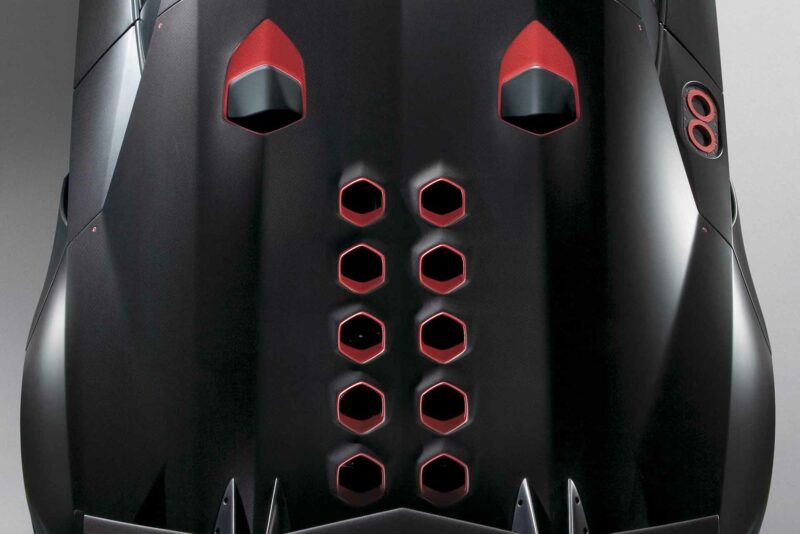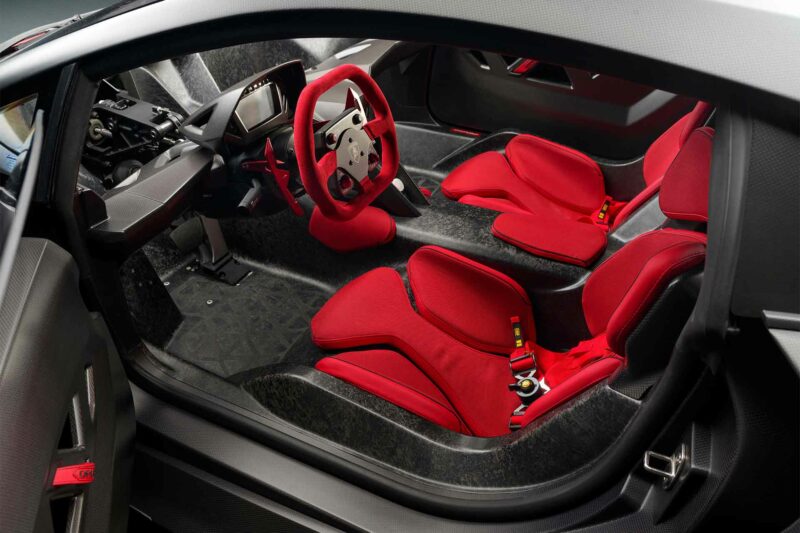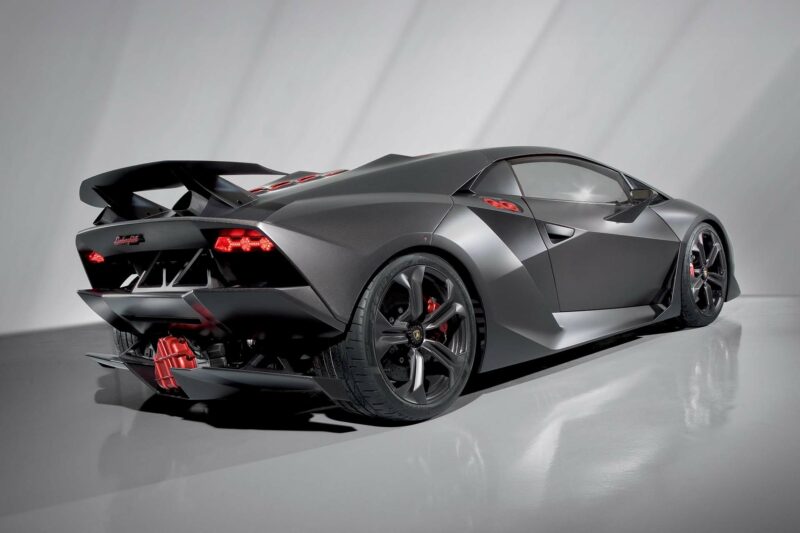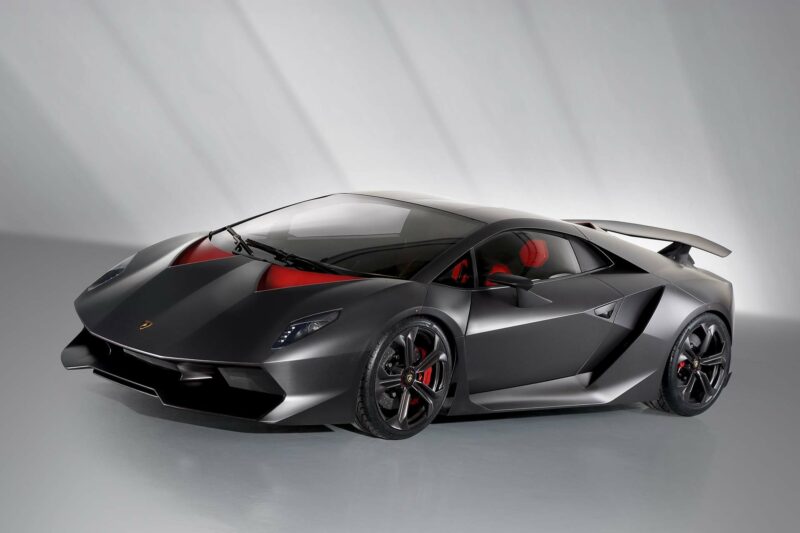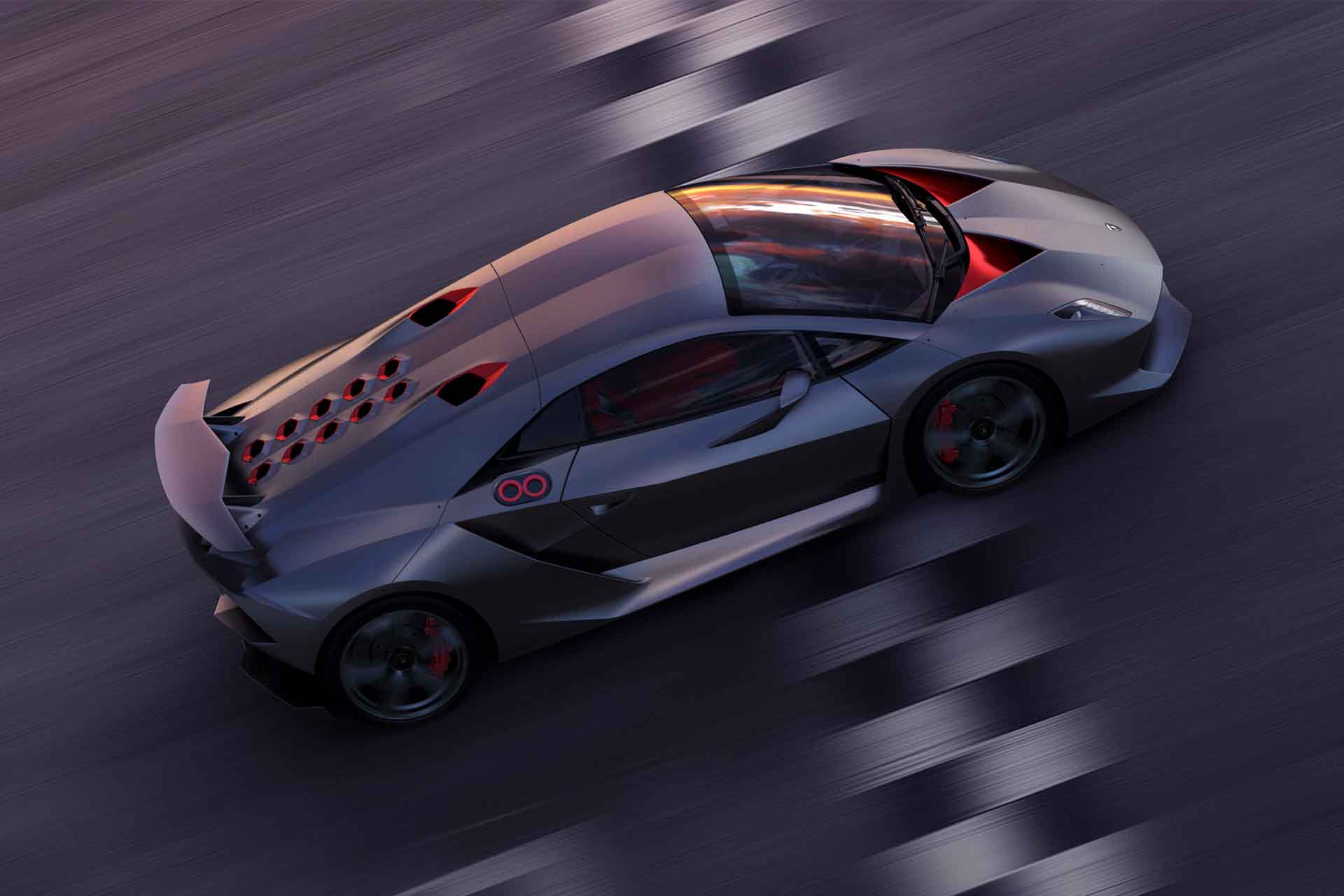Photo Credit: Unknown photographer via 2022 Automobili Lamborghini S.p.A.
Ultralight, Ultrafast. The limited-run, track weapon set a new standard for weight reduction.
Performance
0-60 mph
2.4 s*
Quarter Mile
10.5 s @ 142 mph**
Top Speed
221 mph***
(356 km/h)
* Converted from 0-100 km/h. ** Estimate from FastestLaps.com ***Lamborghini’s claim
About the Sesto Elemento
What if you took the mechanics from a Gallardo LP 570-4 Superleggera, stripped the heavy, non-essential bits (air-conditioning, stereo), and bolted it to a carbon fiber chassis? (The Gallardo’s chassis was aluminum.)
You’d have 562 hp on tap in a car that weighs less than a Mazda MX-5. (2,202 lb. [999 kg])
Needless to say, it was one of the fastest-accelerating cars in history, and it could turn on a dime.
But the weight savings and focus on performance came at a cost few customers were willing to pay: $2.92 million (USD) for a car that is not street-legal. The Sesto Elemento was a limited-run hypercar, and people speculate Lamborghini could only sell ten of the twenty they planned to build.
‘Sesto Elemento’ means “6th Element” in Italian, referring to the 6th element on the periodic table: Carbon. The Sesto Elemento was an experiment in carbon fiber for Lamborghini with partners Boeing and Callaway, and they developed new ways to form carbon fiber, namely forged carbon fiber and hot press forming of carbon fiber sheets.
Model Information
| First Model Year | 2013 |
| Last Model Year | 2013 |
| Engine Type | V10 |
| Induction | Naturally aspirated |
| Drivetrain | AWD |
| Layout | Mid-engine |
| Engine Orientation | Longitudinal |
| Body Style | Coupé |
| Number of Doors | 2 |
| Number of Seats | 2 |
| Front Suspension | Double Wishbone* |
| Rear Suspension | Double Wishbone* |
| Steering Type | Rack and pinion* |
* To Be Confirmed
About The Sesto Elemento
So, how light can a supercar get when you strip away all unnecessary bits and make almost everything out of carbon fiber? Amazingly light, 2,202 lb. (999 kg) to be exact. That is lighter than a Mazda MX-5, Toyota MR2, or VW GTI.
“[The Sesto Elemento] was really an expression of just everything [the Lamborghini team members] were capable of in terms of reduction of weight,” said Ed Bolian in a VinWiki story on YouTube. Ed Bolian was a Lamborghini salesperson during the launch of the Sesto Elemento.
Weight is the enemy of supercars; Lamborghini engineers try to reduce weight so the car accelerates, brakes, and turns better. A lighter car can accelerate faster due to a better power-to-weight ratio. Secondly, handling and road holding improve when weight is reduced, increasing top lateral Gs and making the care more nimble. Reduced weight also improves braking, leading to shorter stopping distances.
You get explosive acceleration when you pair a V10 rotating the wheels with 562 hp and 398 lb.ft of torque and a superlight chassis. The Sesto Elemento borrowed the running gear (engine, transmission, and four-wheel drive system) from the Lamborghini Gallardo LP 570-4 Superleggera. In Italian, “superleggera” means “super light, but the Gallardo Superleggera is 3,350 lb (1,520 kg), which is 52% heavier than the Sesto Elemento. Imagine the acceleration of an already fast car with a third of its weight shaved off… savage!
Much of the weight reduction came from swapping the Gallardo’s aluminum spaceframe for a carbon fiber monocoque, a structural design in automotive and aerospace engineering where the vehicle’s chassis is a single shell made of carbon fiber. A monocoque for a supercar or hypercar is a tub for the driver and passenger, with mounting arms protruding forward and backward to attach the engine, suspension, and bodywork. A carbon fiber monocoque is very rigid, which helps with handling, and the driver and passenger are well protected. Win-win.
When Lamborghini debuted the Sesto Elemento at the 2010 Paris Auto Show, they had already developed the carbon fiber monocoque design for the upcoming Aventador. The Aventador is a production car that had to pass different safety regulations worldwide and be reasonably easy to produce.
Want to learn more about carbon fiber and it’s use in supercars? Check out SuperSportiva’s Guide to Carbon Fiber.
The Lamborghini engineers must have wondered: how light could you get if you made a limited-run track car? There would be no safety regulations to worry about because the car would not be street-legal. There would be no production or cost constraints because it would be a limited-run, multi-million-dollar hypercar. The engineers could make the ultimate superlight hypercar and understand how that affected performance.
Lamborghini went so far with the weight reduction on the Sesto Elemento that there are no seats! There is just a seat-shaped depression in the monocoque with pads attached for comfort.
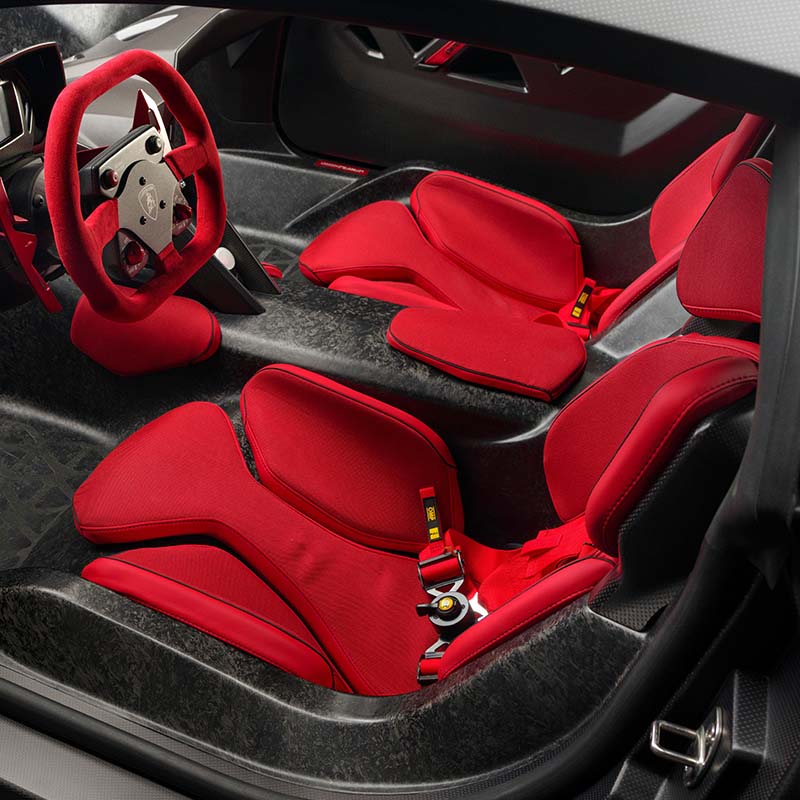
Lamborghini also wanted a car with performance numbers that would grab headlines in the automotive media. In the 2000s, Koenigsegg and Pagani had been aggressive about making hypercars with record-breaking performance numbers and making sure everyone knew about it with savvy public relations. Lamborghini executives wanted that same cachet that came with pushing the limit.
“I’ve said for some time that Pagani have been stealing Lamborghini’s crown when it comes to making the best bedroom wall poster car,” exclaimed Richard Hammond behind the wheel of a Sesto Elemento on a Top Gear segment, “but I think the new boys have just been slapped down.”
So Lamborghini engineers liked the Sesto Elemento as an engineering experiment, and Lamborghini marketers liked it for its public relations value. You know who didn’t like it? Lamborghini’s customers.
Allegedly, Lamborghini only sold ten of the twenty they planned to make. We believe they only made 11; customers took ten, and one was made for the Lamborghini Museum. It is impossible to confirm because Lamborghini has never released the list of VINs. VinWiki lists ten potential Sesto Elementos.
In the automotive industry, “VIN” stands for “Vehicle Identification Number.” A VIN is a unique code, including a serial number, used to uniquely identify individual motor vehicles to track recalls, registrations, warranty claims, thefts, and insurance coverage.
Some aspects of the Sesto Elemento could have been more appealing to buyers.
The first hurdle was the price: $2,920,000 USD in 2013 (over $3,700,000 today). That is high even for ultra-high-end car buyers. For comparison, the MSRP for the LaFerrari was $1,416,362 in 2015.
Collector car buyers are interested in hypercars as a store of value as much as the thrill of driving. They need to know they could sell it for as much or more money as they purchased it for.
A reasonable question potential buyers asked: will the Sesto Elemento sharply depreciate after I buy it?
Some factors would point to depreciation. The Sesto Elemento was the most expensive product Lamborghini had ever tried to sell at that point, so factory buyers may be buying in at a high point. It was also based on a “baby Lambo,” the Gallardo. It was not a purely new model, and the comparison with the Gallardo Superleggera might drag the price down.
Finally, Lamborghini had just started making these limited production collector models; the only limited-run car Lamborghini made before the Sesto Elemento was the Reventón, and that was a million dollars cheaper and road-legal. It was unclear whether limited-run collector cars from Lamborghini would maintain their value or appreciate at this time.
The other significant barrier for potential buyers was that the Sesto Elemento was not road-legal. Not being able to drive your exclusive Lamborghini on the road takes away many of the joyous activities of owning a Lambo: Sunday drives, taking it to a night out, car rallies, show and shine events, etc.
SuperSportiva asked Lamborghini owners what made a Lamborghini worth owning, and most of the positive aspects of ownership would be limited or eliminated in a car like the Sesto Elemento, which isn’t road-legal. The driving experience, sharing the experience with others, stress relief, public adoration, increase in status – all of these are hard when the car has to be in your garage, at a track, or on a trailer going in between.
Suppose you were a high-end Lamborghini buyer who values driving on the track. Having to take your track weapon in a trailer is a hassle. It’s much easier (and part of the magic of a Lamborghini) to have a car that is blisteringly fast on the track but completely drivable on the road or the highway.
People have and will drive their Sesto Elemento on the road in the United States. People can legally drive cars on the road that have not been certified by the National Highway Traffic Safety Administration (NHTSA) if they are imported under the “Show or Display” statutory amendment. Also, when Sesto Elementos are 25 years old in 2037, they will be drivable on the road because they are exempted from the safety concerns as a vintage vehicle.
In conclusion, the Sesto Elemento was a fascinating push by Lamborghini to make one of the fastest cars in the world by reducing weight with innovative uses of carbon composite materials. But it compromised many of the aspects of ownership that Lamborghini buyers valued.
But Lamborghini was learning what the buyers of the ultra-high-end, limited-run hypercars were expecting and what piqued their interest. The technology and marketing of the Sesto Elemento paved the way for other limited-run poster cars like the Veneno, Centenario, and Sián. Lamborghini eventually made a track-only hypercar that was much more successful: The Essenza SCV12.
Gallery
